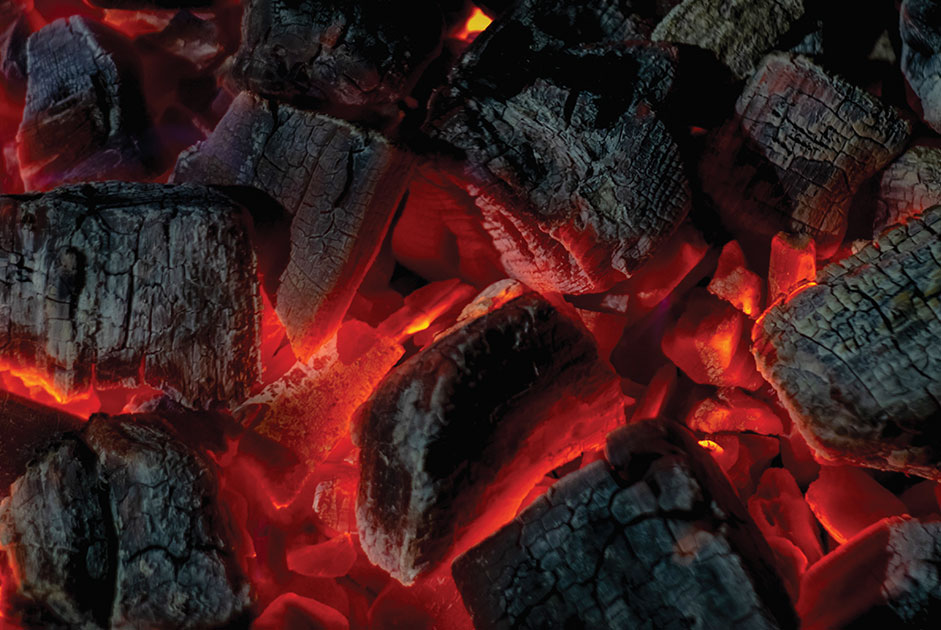BY LISA S.T. DOSS
The enjoyment of a roaring fire continues to be a preferred pastime, whether its from the fireplace or backyard firepit. Despite the dust from the residual remnants, the collected scoops contain one of nature’s amazing gifts. Long before baking soda arrived, wood ash preserved foods, amended gardens, provided natural pest control, leavened baked goods and was an essential ingredient for soapmaking. The minerals, calcium, potassium, aluminum, magnesium, phosphorous and sodium, act as a liming agent to neutralize acidic soils, but that’s not all it can do. The next time you have a full bucket, apply the following uses to your garden and home!
GARDEN
Boosting Nutrients in the Compost: The term “potash” contains a potassium source, a building block of plant health. It comes from soaking ashes in water. As the letter “K” represents the alkali metal, potassium, it achieves a balance of PH levels. A less acidic compost creates the ideal environment for earthworms and increases the decomposition process. As a result, wood ash will ultimately nourish your garden, plants and trees. Avoid acid-loving crops, such as blueberries, rhododendrons, azaleas and potatoes.
Tip: If you live in a location of omnivores, such as bears, spreading a pile of wood ash over the compost prevents animals from entering an open bin.
Calcium Loving Plants: Gardeners often use crushed eggshells and bone meal to prevent a calcium deficiency. Rather than buy bone meal, add a fourth-cup of wood ash to each hole when planting broccoli, cabbage, carrots, cauliflower, celery, lettuce, melons, peppers, potatoes and tomatoes.
Prevent Frost Damage: In containing mineral salts, ash lowers the freezing point of water without damage to a plant’s leaves; therefore, sprinkle your more susceptible vegetables and fruits with ash.
OUTDOORS
Winter Miracle Worker: Just remember wood ash when your walkway or vehicle requires a melting agent. A slight sprinkling on icy spots will melt without damage to the soil or concrete.
Pots and Camping: Combining a small amount of wood ash with water creates a weak lye and soap compound to clean the carbon buildup of outdoor pots, pans and coffee pots!
CRITTER DETERRENT
Slugs and Snails: Use a natural desiccant to eliminate critters with a high-water content. Just create a thin circle around your plants, and the slugs and snails will not cross the barrier. Reapply regularly.
Ants: As insects take over the lawn or infesting an object, the easy solution is to sprinkle wood ash. The presence alone forces ants to relocate.
Skunk Odor Remover: As a natural neutralizer of odors, dust cats or dogs with wood ash and allow them to remain outdoors for a few hours before giving the pet a thorough bath.
Tip: For outdoor animals, dogs, cats, rabbits, cows and chickens, a dust bath of wood ash is an effective way to control fleas and ticks.
HOME
Remove Indoor Humidity: Think of the purpose of baking soda; it absorbs odors from the air. Wood ash also absorbs moisture; therefore, place a small bowl in your refrigerator or musty room, such as a basement or poorly ventilated bathroom, to increase the air quality. One recommendation – check the container regularly.
Tip: Try placing a container in a dark corner to repel bugs.
Glass Cleaner: Combining wood ash with water removes soot from glass panels. The paste also cleans cloudy headlights!
Silver Polish: After dampening a towel, add a small amount of wood ash. This combination polishes tarnished silver!
Absorbs Oil Spills: Since wood ash removes flakes of paint from concrete, it can also take-in other spills, especially oil!
BEST WOOD OPTIONS
Although plentiful in North Carolina, softwood trees, such as cypress, pine or fir result in a short burn, high levels of smoke and creosote buildup. While not all wood burns hot, slow and clean, the best types of hardwoods are maple, oak, ash, birch and fruit trees. If cured, the wood ash provides the highest level of nutrients.
BUCKET OF SAFETY
Fires result each year from the improper disposal of ashes. Winds often arrive to uncover embers and ignite a forest, field or structural fire. It’s vital to wait several days until the embers cool before dumping the contents from a galvanized metal bucket, spreading and soaking with water! For added safety, never cover ashes!


















